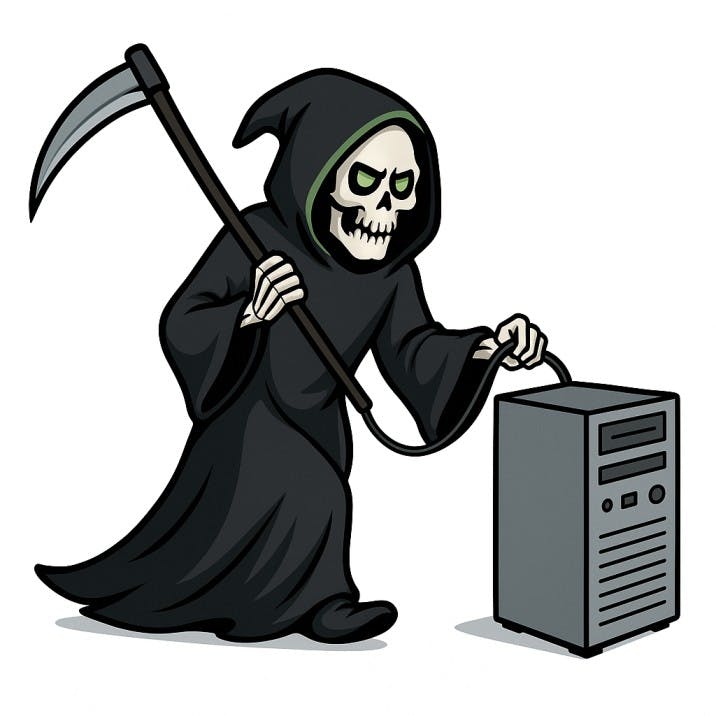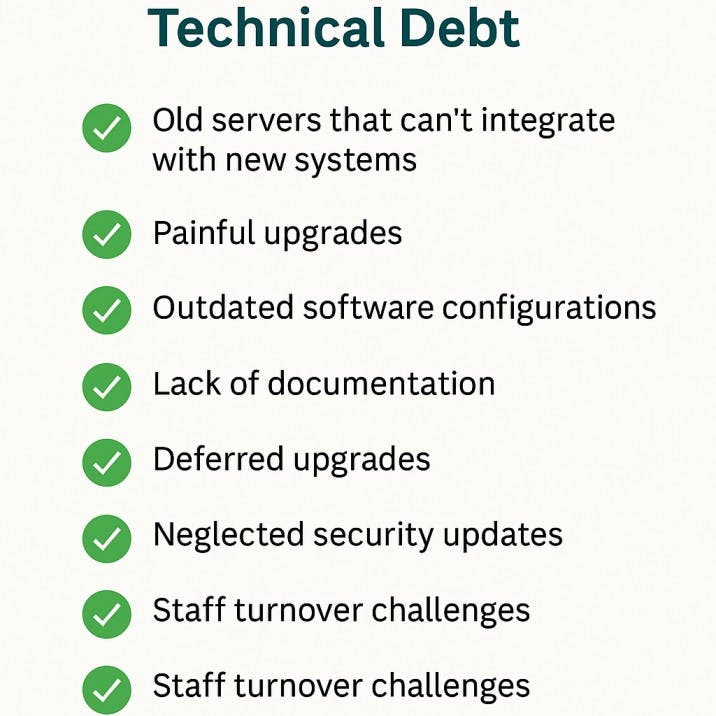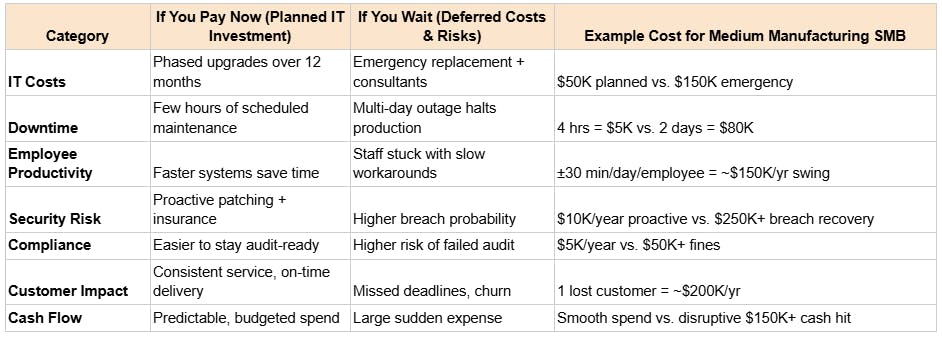What Is Technical Debt (and Why SMBs Should Care)

Technical debt happens when you delay upgrades or take shortcuts in your IT systems. It saves money in the short term but creates bigger costs later when those systems fail, break, or can’t keep up.
It’s a lot like running your business on a maxed-out credit card. You can put off payments for a while, but the interest sneaks up and suddenly you’re paying three times as much for the same thing. Or think about putting off roof repairs. It feels smart to save the money this quarter, until the first rainstorm turns a small leak into water damage across the office.
As our CEO puts it: “The Grim Reaper comes to take the life of your servers and equipment. The debt comes due no matter what.”
Expert insight from David, VP of Technical Services at Consilien: “From the day you build something, you should already be planning how to replace it. Without a retirement plan, patching, and documentation, vulnerabilities pile up and the debt just grows.”

What Technical Debt Means for Small and Medium Businesses
For small and medium businesses, technical debt usually shows up as old technology or infrastructure that hasn’t been upgraded. It’s not always intentional, many companies simply defer upgrades because “the system still works.” But each delay is like swiping that credit card again.
When you don’t continuously invest in IT, you’re building up debt. At some point, the cost comes due. That might mean downtime, system crashes, or exposure to security risks.

Common Examples of Technical Debt in SMBs
- Old servers that can’t integrate with new systems.
- Painful upgrades. For example, when a company tries to install a new server or software, but the older systems refuse to “talk” to it. Instead of a smooth update, the business ends up replacing multiple systems at once, costing far more time and money.
- Outdated software configurations that slow down employee workstations.
- Lack of documentation, leaving new IT staff guessing when they inherit systems.
- Deferred upgrades because “it still works for now.”
- Neglected security updates, which leave systems vulnerable to attacks.
- Staff turnover challenges. When the one employee who understands an old system leaves, the business is left with a black box no one else can maintain.
Real-world example from David: “We still see businesses running servers with Windows 2008. Windows 2016 and older are completely out of support, which means no security patches and no Microsoft support. Often, the apps tied to those servers are so old they won’t run on new versions, forcing costly migrations.”
The True Cost of Technical Debt
Here’s what the “interest” on technical debt looks like for small businesses:
- Lost productivity. Staff waste hours wrestling with slow systems, redoing work, or calling IT for the same issues again and again.
- Bigger security targets. Hackers don’t go after Fort Knox first. They look for easy entry points. Outdated software and unpatched servers are wide open doors.
- Compliance headaches. Running on old systems can mean falling behind on CCPA or other requirements, which leads to audits, fines, or worse.
- Downtime that stings. When your point-of-sale freezes on a busy Friday or your email server crashes, you don’t just lose time, you lose revenue and customer trust.

Good Debt vs. Bad Debt
Not all technical debt is bad. Sometimes, taking on “good” debt makes sense. For example, launching a product quickly to gain a market advantage, with plans to clean up later.
But “bad” debt, like skipping critical updates or running old servers until failure, is reckless and costly.
David’s perspective: “The worst debt comes from waiting until systems are completely unsupported. Continuous upgrades spread out costs and keep you from facing a six-figure emergency bill all at once.”
How IT Architecture Shapes Technical Debt
Not all systems accumulate debt at the same rate. The way your IT is designed makes a big difference.
- Monolithic applications – everything bundled together. Hard to upgrade, expensive to replace.
- Microservices and APIs – smaller components that can be updated independently, reducing future debt.
- Containers and cloud-native – allow fast updates and lower maintenance overhead.
- On-premise vs. cloud – with on-prem, you’re responsible for patching and upgrades. With hosted or SaaS, the provider manages much of it, but you’re still responsible for your data quality and integrations.
How SMBs Can Manage and Pay Down Technical Debt
- Audit your systems – servers, workstations, networks, and software.
- Classify your debt – separate what’s critical from what’s tolerable.
- Prioritize by business impact – cash flow, compliance, and customer trust should guide the order.
- Build repayment into your IT plan – budget for continuous upgrades so you don’t face the Grim Reaper moment.
💡 Example from David: “Think of laptops. Do you wait until year five when they crawl to a stop, or replace them on a three-year cycle? One spreads the cost predictably. The other forces a painful, expensive replacement cycle.”
Do You Have Technical Debt?
Start:
➡️ Do your systems or servers run on technology that’s more than 5 years old?
- Yes → You likely have technical debt.
- No → Next question.
➡️ Do you ever delay upgrades or patches because “the system still works”?
- Yes → That’s technical debt.
- No → Next question.
➡️ Have you had downtime or outages in the past year due to aging systems?
- Yes → Technical debt is impacting your operations.
- No → Next question.
➡️ Would it be hard to recover if your IT lead left tomorrow? (staff turnover risk)
- Yes → That’s technical debt.
- No → Next question.
➡️ Do you budget proactively for IT replacements, or do you wait until something breaks?
- Wait until it breaks → That’s technical debt.
- Budget proactively → You’re managing debt wisely.
Turning Debt Into an Advantage
When SMBs treat IT investments as ongoing, not one-time, technical debt becomes manageable. Paying it down means
- Lower risk of downtime and breaches.
- Better compliance with regulations.
- Improved employee productivity.
- Greater agility to adopt new tools and grow.
Enterprise Architecture as a Service
SMBs often don’t have the luxury of a dedicated enterprise architect. Consilien fills that gap with Enterprise Architecture as a Service, working alongside our vCIO support.
- We inventory your systems and applications.
- We track licensing, renewals, and vendor costs.
- We consolidate overlapping tools to save money.
- We plan cloud migrations and align IT with your budget.
Together with vCIO strategy, enterprise architecture keeps your IT both compliant and future-ready.
Key Takeaways for SMB Leaders
- If you don’t invest in IT, you’re building up debt that costs more later.
- Debt always comes due. It’s better to plan than panic.
- Architecture and lifecycle planning matter. They determine how fast debt builds up.
- Continuous upgrades and enterprise architecture services reduce the long-term burden.
- Consilien can help you audit, plan, and manage your IT roadmap before the Grim Reaper shows up.
Not sure how much technical debt your business is carrying?
Consilien can help you audit, plan, and manage your IT roadmap, before the Grim Reaper shows up.